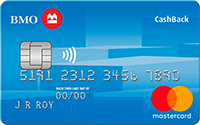 With no annual fee, a $15,000 annual income requirement and a promotional interest rate of 1.99% on balance transfers for your first 9 months (with a 1% transfer fee), the BMO CashBack is perfect if you’re in a low income bracket and want to get a handle on your credit card balance. This card can also put some of your everyday spending money back in your pocket: Get 5% cash back in your first 3 months. The regular rate is 3% on groceries and 1% on recurring bill payments (up to $500 spent per month in each category and an unlimited 0.5% on everything else). The card includes standard insurance coverage, like extended warranty and purchase protection, too.
With no annual fee, a $15,000 annual income requirement and a promotional interest rate of 1.99% on balance transfers for your first 9 months (with a 1% transfer fee), the BMO CashBack is perfect if you’re in a low income bracket and want to get a handle on your credit card balance. This card can also put some of your everyday spending money back in your pocket: Get 5% cash back in your first 3 months. The regular rate is 3% on groceries and 1% on recurring bill payments (up to $500 spent per month in each category and an unlimited 0.5% on everything else). The card includes standard insurance coverage, like extended warranty and purchase protection, too.
Get more details about the BMO CashBack Mastercard*
What is a balance transfer?
A balance transfer is the transfer of debt from one credit card to another. Although a cardholder can transfer their debt for a variety of reasons, the goal is usually to cut down on the amount of interest charged and pay off the loan faster.
As most everyday-use credit cards command an interest rate of around 20%, your principal debt load can bloat quickly. By transferring debt to a card with a lower interest rate, you’ll incur lower interest charges—so more of your money goes to the principal balance.
Important things to know about balance transfer credit cards
Balance transfers can be an effective way to consolidate and address debt. But before you jump in, there are seven main variables you need to understand.
- Shop around for the rate, timing and terms that suit you best
If you’re trying to eliminate credit card debt, your best bet might be a balance transfer credit card. These cards come with promotions that let cardholders pay very low interest (sometimes as little as 0%) for a limited time (like six or 10 months). These offers can be a really effective way to bring down your debt, fast, if you are disciplined about making regular payments and are not racking up a lot of new purchases. The card you choose will depend largely on what’s available when you’re looking, how long you think you’ll need to pay off your debt, and the card’s other terms. - Make sure you’re eligible for the balance transfer
Balance transfer promotions are only valid when moving debt from a credit card at one bank to a card at another bank. It will not work between two cards from the same bank. - Timing is everything
Balance transfer promotions are available at the time that you make your application or sometimes shortly thereafter. Be strategic about when you apply, and make sure you’re prepared to make the transfer. That means having the credit card company name, your name as it appears on the card, the debt total and the credit card number. - Remember that balance transfer promotions don’t last forever
The low, single-digit rates available on balance transfer credit cards are limited-time offers. Once the promotional period is over, the cards’ regular interest rates will kick in, which will affect your monthly payments. How you handle this will depend on the amount of your debt and how quickly you think you can pay it off. But, in general, the best strategies are to pay off the balance before the balance transfer offer ends, and to pick a card with a low regular interest rate. This way, you’ll save money on interest even if you still owe after the offer period. - Make your minimum payments
Even when taking advantage of a balance transfer offer, you must make at least the minimum payment on the card, on time, each month. If you don’t, that super-low promotional interest rate can quickly be discontinued and the standard interest rate will kick in almost immediately. In other words, only take advantage of a balance transfer offer if you have the cash on hand to make at least the minimum payment each month and you’re in the right financial mindset to take on debt repayment. - Balance transfer fees
Some—but not all—cards charge a fee for balance transfers. This fee is expressed as a percentage of the total amount you want to move, and it usually ranges from 1% to 3%. So, for example, if you’re looking to transfer $1,000 in debt to a card with a 3% fee, your opening balance will be $1,030. The additional cost may well be worth the money you’ll save at the new lower interest rate. But keep your eyes open for fee deals: Occasionally, a card will run a promotion where the balance transfer fee is waived. - Separate your expenses
If you charge a new purchase to your balance transfer card, this spend will be charged at the card’s regular interest rate if you don’t pay on time, not the promotional rate that’s applied to the balance you’ve transferred. This might not seem like a big deal, especially if you’ve been lucky enough to find a card with a lower regular rate, but there’s an additional catch: Most credit cards apply payments to debt marked at the low or promotional rate first, which means your high-interest purchases are sitting there longer, racking up interest. If you’re trying to pay down debt, this only compounds the problem. It’s good practice to leave your balance transfer card at home and use a different financial product (like debit, cash or even a different credit card) for new purchases.
Do you earn cash back on balance transfers?
Like cash advances or purchases of money orders, balance transfers are not considered to be purchases, so in general, they’re not eligible for cash back rewards. There may be some rare exceptions with certain promotional offers, but these are few and far between. That said, the interest saved by moving your debt to a card with a lower interest rate will far outweigh the value of most cash back returns.


